Kometos fortas II Antrasis pasaulinis karas
Pirmosios žinios apie įtvirtinimų statybą Dauguvos žiotyse siekia 1205 m., kai netoli dešiniojo Dauguvos kranto, dabartinėje Vecdaugavoje, kuri buvo pagrindinė Dauguvos žiotys, pradėtas cistercų vienuolyno ir pilies statymas. Pilis tapo tvirtove, kuri per karus buvo kelis kartus sugriauta ir atstatyta. XVIII a., vykdant Dauguvos kranto reguliavimo darbus, Dauguvos tvirtovė buvo palaipsniui perkeliama nuo upės žiočių. Siekdama užtikrinti saugią upės žiotis laivybai ir išvengti seklumų susidarymo, 1765 m. Švedijos vyriausybė pradėjo užtvankos statybą dešiniajame upės krante priešais tvirtovę. Užtvankos gale buvo įrengta patrankų baterija, kuri priminė kometos galvą, o pati užtvanka – jos uodegą, todėl naujasis statinys buvo pavadintas Kometos fortu. Šešis tvirtovės spindulius supa bastionai, kuriems jų projektuotojas, švedų inžinierius Erikas Dahlbergas, suteikė astronominius pavadinimus – Ryto žvaigždė, Sietas, Pietų ašigalis, Laimės ratas, Jūros žvaigždė ir Šiaurės ašigalis.
Tęsiant žiočių reguliavimo darbus, Komētfortas atsidūrė kairiajame Dauguvos krante. 1912 m. Mangalsaloje ir Bolderājoje pradėta statyti keletas fortų. Buvo pastatyti du fortai su 254 mm pabūklais, šeši fortai su 152 mm pabūklais ir trys fortai su 138 mm pabūklais. Kiekviename forte buvo įrengta po du pabūklus. Šiandien Komētfortas yra vietinės reikšmės istorijos paminklas, kurio atradimas buvo vienas iš pagrindinių veiksnių, kodėl buvo sustabdyta naujo uosto terminalo statyba Daugavgryvoje.
Grafienės fortas taip pat buvo įkalinimo vieta daugeliui žymių asmenų. Kuršo ir Žiemgalos kunigaikštis Jokūbas su visa šeima čia buvo trumpam įkalintas, nes sutiko bendradarbiauti su Švedijos valdžia. Nuverstas Rusijos caras Ivanas VI buvo čia įkalintas 1743/44 m., būdamas pusantrų metų. Daugavgryvos tvirtovėje trumpam buvo kalinamas ir Liudvikas XVIII. XIX amžiuje Daugavgryvos tvirtovėje buvo kalinami politiniai kaliniai, įskaitant ir kitų tikėjimų atstovus. Po Antrojo pasaulinio karo tvirtovėje buvo įkurta darbo stovykla.
Daugiau informacijos šaltinių
https://apkaimes.lv/daugavgriva/vesture/
http://www.citariga.lv/lat/rigas-apskates-vietas/rigas-nocietinajumi/kometforta-dambis/
https://lr1.lsm.lv/lv/raksts/latvijas-perles/bolderaja-zviedru-projektetais-daugavgrivas-cietoksnis-un-nekart.a91383/
Jūsų komentarai
Susijusi laiko juosta
Susijusios vietos
Mangalsalos įtvirtinimai
Pakrantės įtvirtinimai yra Rygoje, Mangaļsaloje, Dauguvos žiotyse, priešais Dauguvgryvą. Čia galima pamatyti skirtingų armijų (rusų, latvių, vokiečių ir sovietų) pastatytus įtvirtinimus. Mangaļsalos įtvirtinimai buvo pastatyti siekiant ginti Rygos miestą nuo priešo laivynų. Ši teritorija ilgą laiką buvo strategiškai svarbi. Po Pirmojo pasaulinio karo Latvijos armija dar neturėjo stipraus laivyno. Jūrų siena buvo ilga, o pakrančių gynyba darėsi vis sunkesne užduotimi. Latvijos armija perėmė Rusijos imperijos pastatytus įtvirtinimus XIX a. pabaigoje ir XX a. pradžioje ir išplėtė gynybos sistemą. Dauguvgryvos ir Mangaļsalos artilerija apšaudydavo priešo laivus, bandančius įplaukti į Dauguvos žiotis, o atramos punktai Lielupės (Jūrmalos) ir Gaujos (Carnikavos) žiotyse stabdydavo priešo desantinius būrius. Taip pat buvo specialiai įrengtas šarvuotas pakrantės gynybos traukinys, kuris galėjo teikti artilerijos ugnį ir paramą Saulkrastų arba Jūrmalos kryptimi. Strateginių vietų įtvirtinimo tikslas buvo maksimaliai padidinti ginklų panaudojimą, pasitelkiant specialias konstrukcijas ir reljefo pranašumus. Pakrantės gynybiniai įtvirtinimai buvo išdėstyti didelėje teritorijoje, kad karo atveju būtų galima atremti priešo pastangas.
Garso gidas https://izi.travel/en/edbf-mangalsala-fortifications/en
Daugavgryvos tvirtovė
Daugavgryvos tvirtovė (įėjimas iš Birzės gatvės) yra Daugavgryvos saloje, kur Bulupės upė įteka į Dauguvos upę. Tvirtovė buvo pastatyta XVII a., siekiant apsiginti nuo priešų, judančių Rygos kryptimi, kuri buvo svarbus administracinis, prekybos ir gamybos centras. Vėliau ji tapo pagrindiniu Latvijos armijos pakrantės gynybos įtvirtinimu su keliais atramos taškais. Ši gynybinė įtvirtinimų sistema yra vienas vertingiausių Latvijos karinio paveldo objektų. Ši tvirtovė yra Latvijos karinės istorijos liudininkė. Pavyzdžiui, Krymo karo metu (1853–1856 m.) čia buvo mokomos Latvijos ir Estijos patrankinių valčių įgulos. Pagrindinis šių dalinių tikslas buvo ginti vietos uostus ir pakrantę nuo britų karinio jūrų laivyno atakų. Pirmojo pasaulinio karo metu čia buvo suformuotos Daugavgryvos milicijos kuopos. Tai buvo pirmieji Latvijos koviniai daliniai, atsiradę dar anksčiau nei Latvijos šauliai. Šiandien galima pamatyti tvirtovės teritoriją. Netoliese yra Kometfortas ir Pajūrio gamtos parkas, o kitoje Dauguvos pusėje – Mangaļsalos įtvirtinimai.
Pakrantės gynybos baterijos Bolderajoje
Įsikūręs Bolderājoje – į rytus nuo Lielupes gatvės ir į pietryčius nuo Jātnieku gatvės Dauguvos krante.
Išliko keturių susprogdintų baterijų pozicijų liekanos. Šios baterijos, kuriose buvo 152-ojo kalibro patrankos, yra buvusios Rygos įtvirtinimų sistemos dalis, kurios tikslas buvo apsaugoti miestą nuo užpuolikų, ateinančių iš jūros. Iš baterijų viršaus aiškiai matyti Dauguva ir naujai užlieta šiaurinė Krievu salos dalis.
2023 m. pabaigoje, vykdant teritorijos tvarkymo darbus, viena iš keturių baterijų buvo iš dalies sunaikinta.
Susijusi istorija
Kariuomenės buvimas Mangalsaloje
Atsiminimuose ryškūs įspūdžiai apie Latvijos kariuomenės buvimą Mangalsaloje. Aprašomi fortai, taip pat sapierų pastatytas gelžbetoninis įtvirtinimas. Atsiminimuose aprašomas karių kasdienis gyvenimas, gyvenimo ritmas ir iliustruojama Mangalsalos aplinka. Mangalsalos ir Latvijos armijos karių vizitas.
Apie Daugavgryvos tvirtovę
Pasakotojas aprašo įvykį Daugavgryvos tvirtovėje Pirmojo pasaulinio karo metu, kai ją subombardavo vokiečių armijos dirižablis. Tvirtovė buvo vienas iš strateginių objektų, išlaikiusių savo svarbą iki Antrojo pasaulinio karo pabaigos.




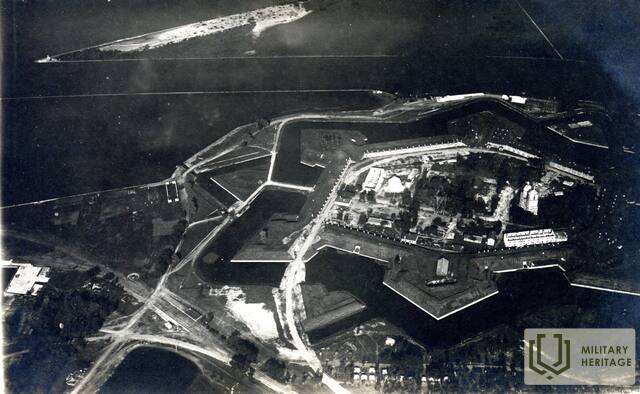

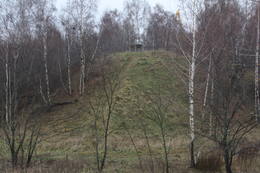
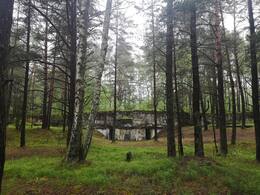
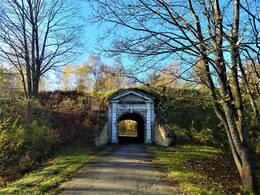
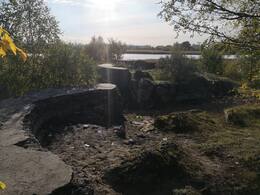
Apie kometos fortą. 1765 m. Švedijos vyriausybė niekaip negalėjo duoti užduoties statyti forto, nes ši teritorija nuo 1721 m. buvo Rusijos imperijos dalis.